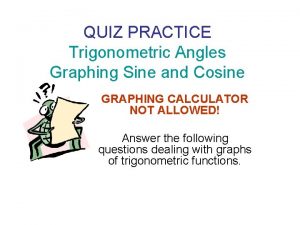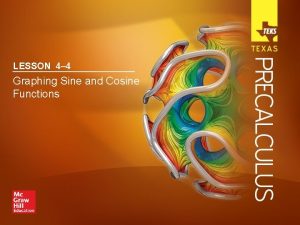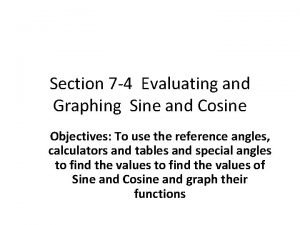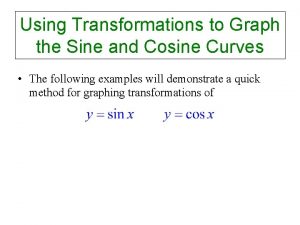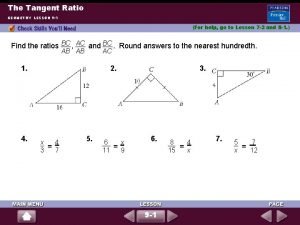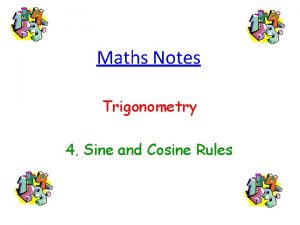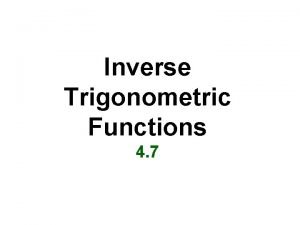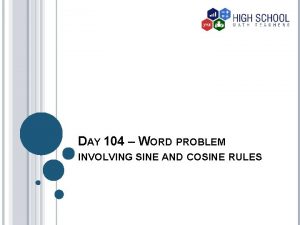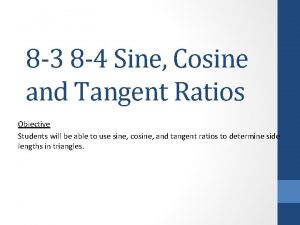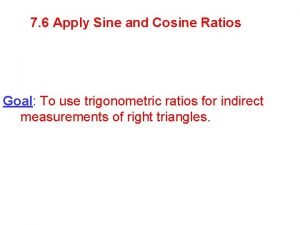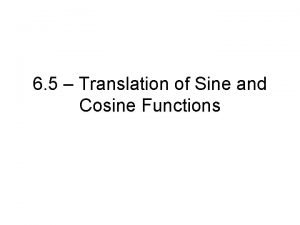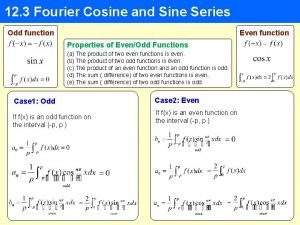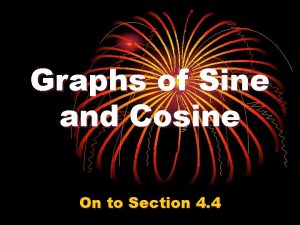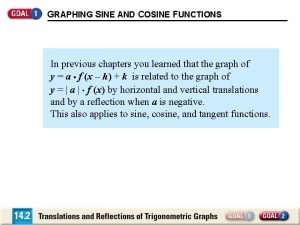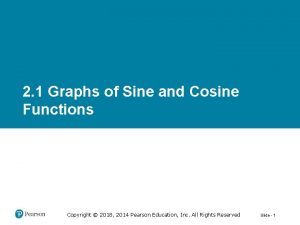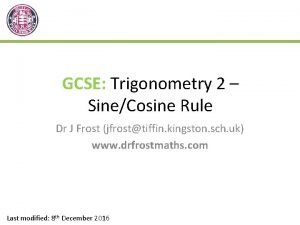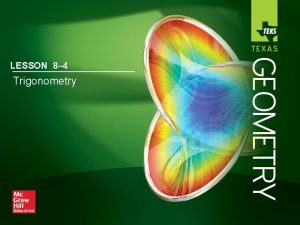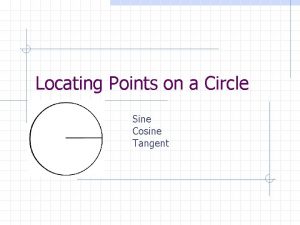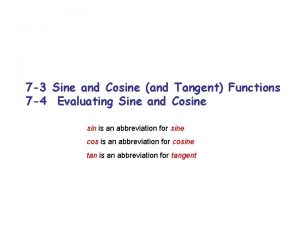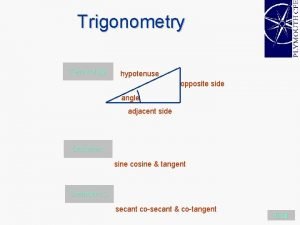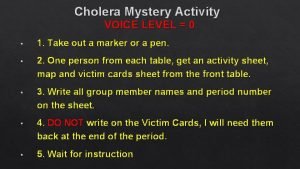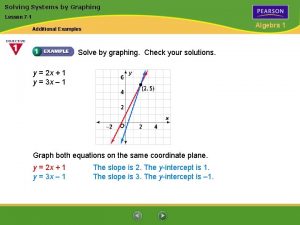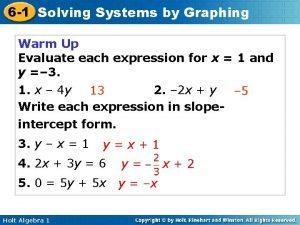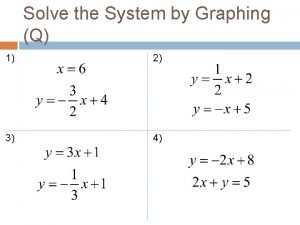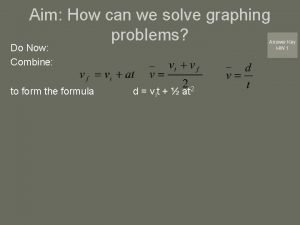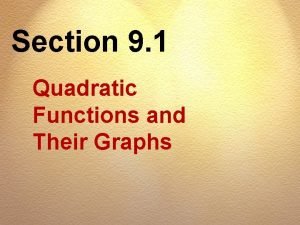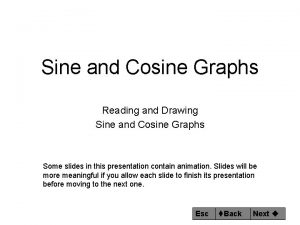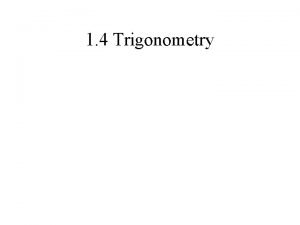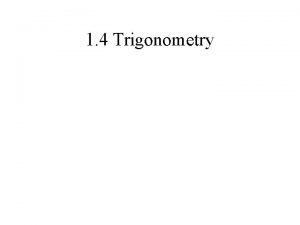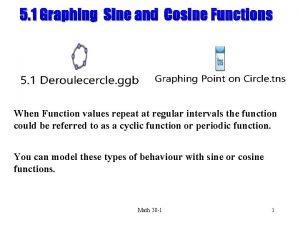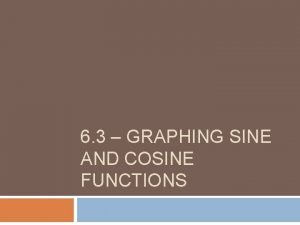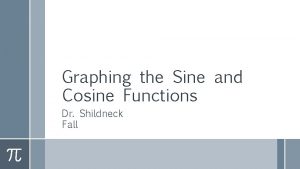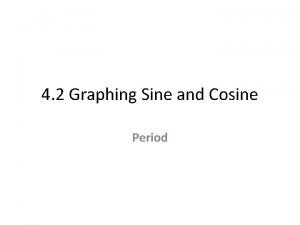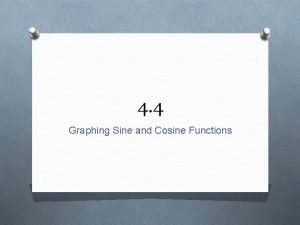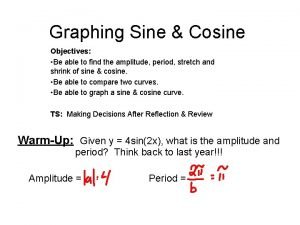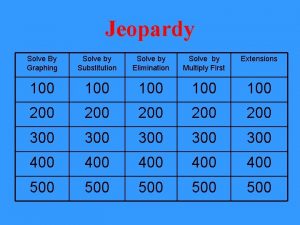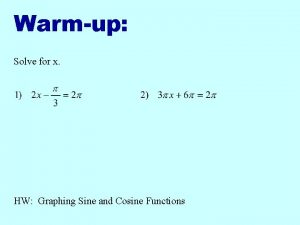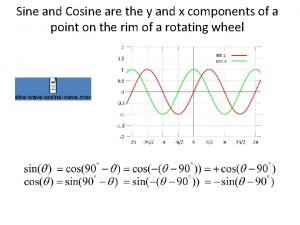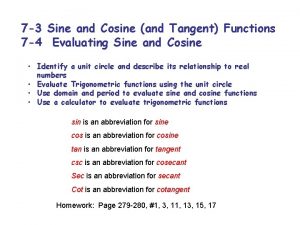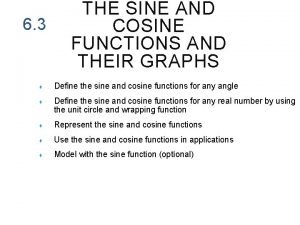Solve the puzzle Graphing sine and cosine Ch























































- Slides: 55

Solve the puzzle

Graphing sine and cosine Ch 8: day 2:

agenda • Tides question • Graphing sine and cosine • period • amplitude • Notes on building trig equations: tides problems, rotating wheel problems • Review solving equations

Ponder

My boat needs 5 feet of water to leave the dock. When can I leave, and how long can I be out? • What information do you need to answer this question? • Low tide at 6 AM • How tide at 12 noon • Water level at low tide = 2. 5 feet • Water level at high tide = 35 feet • Write a sine equation to model the water level. Let low tide represent time zero.

Solve by graphing •

4. 4 Periodic Functions; Stretching & Translating Graphs Periodic Function: A continuing function whose y values repeat at constant intervals

Examples:

Based on these examples, how would you define period?

Period: • Period is the horizontal distance on the graph of a periodic function that represents the length of one complete cycle. It is denoted as p. p = 5 • The y-coordinate of the graph at x is the same as the y-coordinate of the graph at (x +p). And (x+mp) Ex: The y-coordinate at 0 is the same as the ycoordinate at 0+5. (0, 1) (5, 1) (10, 1), etc…


Period vs Fundamental Period What is the period of this function? The fundamental period is 1, so any integer would also be considered a period.

Guess the Amplitude

Amplitude: • M = Maximum y-value and m = minimum y-value

Give the period and amplitude


Give the period and amplitude


Period and amplitude?


Period and amplitude?

P =3, A = 1. 5

y = A sin B (x – h) + k and y = A cos B (x – h) + k Copyright © 2009 Pearson Education, Inc.

Equation of a Sine Function Amplitude Period Complete Cycle

Draw one cycle of the function’s graph. Amplitude Period

Draw one cycle of the function’s graph. Amplitude Period

Draw one cycle of the function’s graph. Amplitude Period

Equation of a Cosine Function Amplitude Period Complete Cycle

Draw one cycle of the function’s graph. Amplitude Period

Draw one cycle of the function’s graph. Amplitude Period

Draw one cycle of the function’s graph. Amplitude Period

Graph the function. Amplitude Period Reflectio n over xaxis

Graph the function. Amplitude Period Reflection over x-axis

34 y -19π 6 -3π -11π 6 -7π 6 1 5π 6 π -2π -π 13π 6 17π 6 2π 3π 25π 6 x y= 4π -1 All the solutions for x can be expressed in the form of a general solution. Copyright © by Houghton Mifflin Company, Inc. All rights reserved.


SOLVING FOR ANGLES THAT ARE NOT ON UC We will work through solutions algebraically and graphically. Learning both methods will enhance your understanding of the work.


Method 1: Algebraically: Step 1 Set the calculator in degree mode and use the inverse sine key

FIND THE FINAL ANSWER(S) FOR THE GIVEN • Since the answer given by your calculator is NOT RANGE. between 0 and 360 degrees, find the proper answers by using RA. Check your answers:


SOLVING GRAPHICALLY Zoom Trig Use the intersect key again to find the second value.


Method 1: Algebraically: Step 1 Set the calculator in radian mode and use the inverse sine key

STEP 2: DETERMINE THE PROPER QUADRANT •



Method 2: Graphically: Step 1 Set the calculator in radian mode.

Use your Knowledge of trig functions to choose an appropriate window Use the intersect Key once more for the second point of intersection. i. e solution.

When you use the graphing method, you can easily see there is more than one solution. When using the graphing method, it might take a while to set the window properly. The algebraic method is quicker, however, you have make sure to look for a possible second answer.

• To solve an equation involving a single trigonometric function, we first transform the equation so that the function is alone on one side of the equals sign. Then we follow the same procedure used in Example 1.

• EXAMPLE 2

• FIND THE APPROPRIATE QUADRANT

ANOTHER WAY; IGNORE THE NEGATIVE SIGN. •

GRAPHING CALCULATOR: Although this is a reasonable window to start with, it does not capture the graph. So change Ymin and Ymax.

 Graphing sine and cosine quiz
Graphing sine and cosine quiz Sinusoids lesson 4-4 answer key
Sinusoids lesson 4-4 answer key Trigonometric graph equation
Trigonometric graph equation Sine rule graph
Sine rule graph Graph transformations
Graph transformations Sine function transformations
Sine function transformations Practice 9-1 the tangent ratio answers
Practice 9-1 the tangent ratio answers When do we use sine rule
When do we use sine rule Sine and cosine law maze
Sine and cosine law maze Sine rule and cosine rule
Sine rule and cosine rule Trigonometry cosine rule
Trigonometry cosine rule Cos^-1
Cos^-1 When to use sine and cosine rule
When to use sine and cosine rule Cosine word problems
Cosine word problems Practice 8-4 sine and cosine ratios geometry
Practice 8-4 sine and cosine ratios geometry Sine and cosine ratios
Sine and cosine ratios 6-5 practice translations of sine and cosine functions
6-5 practice translations of sine and cosine functions Fourier sine and cosine series examples
Fourier sine and cosine series examples Partner of sine and cosine
Partner of sine and cosine Cos wave formula
Cos wave formula Graph of sine and cosine functions
Graph of sine and cosine functions Cosine graph reflection
Cosine graph reflection Sinusoidal graphs
Sinusoidal graphs Transformations of sine and cosine functions
Transformations of sine and cosine functions Dr frost trigonometry
Dr frost trigonometry The sine and cosine curves intersect infinitely
The sine and cosine curves intersect infinitely Sin(0)
Sin(0) Lesson 8-4 sine and cosine ratios answers
Lesson 8-4 sine and cosine ratios answers Tangent ratio
Tangent ratio Half range sine series solved examples
Half range sine series solved examples Magic triangle trig
Magic triangle trig Sine cosine tangent circle
Sine cosine tangent circle Sin and cos in quadrants
Sin and cos in quadrants Adjacent side definition
Adjacent side definition Law of torts
Law of torts Write an equation and solve for x
Write an equation and solve for x Lex stricta
Lex stricta Nulla poena sine lege
Nulla poena sine lege Solve cracker barrel puzzle
Solve cracker barrel puzzle Algorithm vs heuristic psychology
Algorithm vs heuristic psychology Voice level 0
Voice level 0 Solve the puzzle using the clues below
Solve the puzzle using the clues below Problem formulation for 8 puzzle problem
Problem formulation for 8 puzzle problem Solve picture puzzle
Solve picture puzzle Lesson 7 solve systems of equations by graphing
Lesson 7 solve systems of equations by graphing Solve each system of inequalities by graphing
Solve each system of inequalities by graphing 6-1 solving systems by graphing
6-1 solving systems by graphing Solve by graphing
Solve by graphing Solve by graphing
Solve by graphing Solve systems of linear inequalities by graphing calculator
Solve systems of linear inequalities by graphing calculator Solve system of inequalities by graphing
Solve system of inequalities by graphing 9-1 practice graphing quadratic functions
9-1 practice graphing quadratic functions Hát kết hợp bộ gõ cơ thể
Hát kết hợp bộ gõ cơ thể Frameset trong html5
Frameset trong html5 Bổ thể
Bổ thể Tỉ lệ cơ thể trẻ em
Tỉ lệ cơ thể trẻ em
